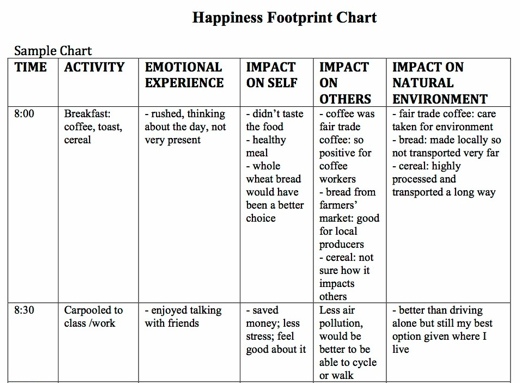 You’ve probably had the experience of “catching” someone’s good mood. Happiness can be contagious. Sometimes it’s passed along through simple gestures – a warm smile from a stranger; someone holds a door for you; another driver lets you in. It feels great to be on the receiving end of another person’s good spirits. These brief interchanges between one or more people are tiny portraits of a massive canvas that spans the globe. Every day, too, your life touches other species and the natural environment. These encounters leave a footprint in the world. Sometimes we’re contributing to happiness and wellbeing, and sometimes (often unwittingly) we are not.
You’ve probably had the experience of “catching” someone’s good mood. Happiness can be contagious. Sometimes it’s passed along through simple gestures – a warm smile from a stranger; someone holds a door for you; another driver lets you in. It feels great to be on the receiving end of another person’s good spirits. These brief interchanges between one or more people are tiny portraits of a massive canvas that spans the globe. Every day, too, your life touches other species and the natural environment. These encounters leave a footprint in the world. Sometimes we’re contributing to happiness and wellbeing, and sometimes (often unwittingly) we are not.
Let’s take your morning cup of coffee or tea as an example. We know that being mindful of the experience can generate positive emotions and may even reduce stress. Paying attention to enjoying the aroma, the warmth of the cup, the sounds around us, and the company we are with is relaxing and enhances wellbeing.
The perspective that many happiness experts have overlooked, however, is that we don’t exist in isolation. Our momentary pleasure needs to be placed in a wider context. If we are drinking fair-trade coffee, that means that coffee producers have been paid fairly (just as we like to be paid fairly), and the coffee was grown with regard for the environment.
This, then, is an example of something I call “sustainable happiness”. It’s happiness that contributes to individual, community, or global wellbeing without exploiting other people, the environment or future generations.
If you would like to expand your happiness footprint there’s a very simply thing you can do. Keep track of your activities for one day, using the chart below (download the pdf). Once you’ve filled in the chart, ask yourself if there is one thing that you want to shift so that you are contributing more to your own wellbeing, the wellbeing of others, or the natural environment.
Here’s some of the things that other people have done after completing their Happiness Footprint Chart:
- switched from using plastic water bottles to a reusable one
- turned off the TV for a week and planned a week of board games with the kids
- committed to going for a walk after supper instead of a drive
- reduced consumption of fast foods (better for her health and reduced waste)
- started buying produce from a local farmers’ market.

Read more about sustainable happiness at www.sustainablehappiness.ca.
Catherine is a professor at Cape Breton University in Nova Scotia, Canada where she teaches the world’s first university course on sustainable happiness. She recently participated in the High Level meeting at the United Nations that focused on realizing a world of sustainable happiness and sustainable wellbeing. Her Sustainable Happiness Course includes videos and practical activities designed to help you explore sustainable happiness.



















